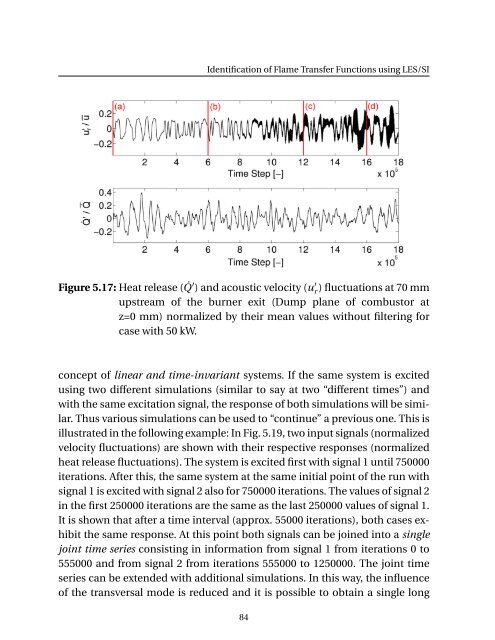Numerical Simulation of the Dynamics of Turbulent Swirling Flames
Numerical Simulation of the Dynamics of Turbulent Swirling Flames
Numerical Simulation of the Dynamics of Turbulent Swirling Flames
You also want an ePaper? Increase the reach of your titles
YUMPU automatically turns print PDFs into web optimized ePapers that Google loves.
Identification <strong>of</strong> Flame Transfer Functions using LES/SI<br />
Figure 5.17: Heat release ( ˙Q ′ ) and acoustic velocity (u r ′ ) fluctuations at 70 mm<br />
upstream <strong>of</strong> <strong>the</strong> burner exit (Dump plane <strong>of</strong> combustor at<br />
z=0 mm) normalized by <strong>the</strong>ir mean values without filtering for<br />
case with 50 kW.<br />
concept <strong>of</strong> linear and time-invariant systems. If <strong>the</strong> same system is excited<br />
using two different simulations (similar to say at two “different times”) and<br />
with <strong>the</strong> same excitation signal, <strong>the</strong> response <strong>of</strong> both simulations will be similar.<br />
Thus various simulations can be used to “continue” a previous one. This is<br />
illustrated in <strong>the</strong> following example: In Fig. 5.19, two input signals (normalized<br />
velocity fluctuations) are shown with <strong>the</strong>ir respective responses (normalized<br />
heat release fluctuations). The system is excited first with signal 1 until 750000<br />
iterations. After this, <strong>the</strong> same system at <strong>the</strong> same initial point <strong>of</strong> <strong>the</strong> run with<br />
signal 1 is excited with signal 2 also for 750000 iterations. The values <strong>of</strong> signal 2<br />
in <strong>the</strong> first 250000 iterations are <strong>the</strong> same as <strong>the</strong> last 250000 values <strong>of</strong> signal 1.<br />
It is shown that after a time interval (approx. 55000 iterations), both cases exhibit<br />
<strong>the</strong> same response. At this point both signals can be joined into a single<br />
joint time series consisting in information from signal 1 from iterations 0 to<br />
555000 and from signal 2 from iterations 555000 to 1250000. The joint time<br />
series can be extended with additional simulations. In this way, <strong>the</strong> influence<br />
<strong>of</strong> <strong>the</strong> transversal mode is reduced and it is possible to obtain a single long<br />
84
















